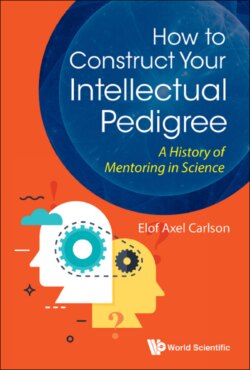Читать книгу How to Construct Your Intellectual Pedigree - Elof Axel Carlson - Страница 9
На сайте Литреса книга снята с продажи.
Оглавление2 The Origin of Academic Pedigrees
People have used pedigrees for many endeavors. The idea goes back to Biblical times and the Old Testament has numerous lists of family members across dozens of generations. They were first used in a more structured way to identify family histories or genealogy. This included royal families. Present monarchs in countries with a royal lineage can trace these pedigrees back to the Middle Ages or earlier. In the mid-Nineteenth Century Francis Galton used pedigrees to study talents and other traits running in families (Figure 1). His own family of Galtons, Darwins, and Wedgwoods is an example [1]. Galton’s pedigree analysis of intellectual and sports ability were forerunners of the pedigrees used in the eugenics movement especially by Charles Davenport and Harry Laughlin at the Eugenics Record Office in Cold Spring Harbor, NY [2]. Many geneticists recognized that these were highly influenced by bias when they included traits like becoming bankers, carpenters, physicians, or sea captains, among the talented and becoming criminals, paupers, or mentally deficient (in those days the terms “feebleminded” and “unfit person” were used) [3]. After WWII and the abuses of Nazi racial ideology that expanded the approach started by the Eugenics Record Office, such pedigrees for social traits were avoided. Instead they were used for taking family histories by physicians and studied in detail for medically significant traits for a field that became known as genetic counselling pioneered by Sheldon Reed (1910–2003) [4]. An additional use of family pedigrees was introduced by Murray Bowen (1913–1990) to work out family dynamics among relatives across three generations. A religious use of pedigrees is widely used by the Latter Day Saints (LDS or Mormons) who require members to prepare extensive pedigrees of their ancestral families so that they can be assimilated into the Mormon family [5].
Figure 1: The Galton-Darwin-Wedgwood pedigree used by the Eugenics Record Office at Cold Spring Harbor to illustrate inheritance of talent and high intelligence.
Galton used dictionaries of biography and scores obtained from competitive examination among top students in mathematics, classics, and other fields of knowledge. These pedigrees were also used in the eugenics movement that Galton founded, especially by Charles Davenport and his staff at the Eugenics Record Office in Cold Spring Harbor during the first third of the twentieth century. Earlier pedigrees were largely used for the nobility who traced their ancestry to the founding dynasties of their present rulers. The first academic pedigrees to appear as mentoring relations among geneticists were introduced by Alfred Henry Sturtevant in his 1965 book, A History of Genetics [Figure 2] [5]. Today, there are several sources for scholars to trace their mentors. The Academic Family Tree is probably the largest with 38 disciplines on file. There are separate files on-line for physicists, mathematicians, philosophers, neurologists, and chemists. There is also an automatic program that can generate pedigrees of PhD mentors going back at least to the first dissertation-based academic PhDs that began under the Humboldt brothers, Alexander and Wilhelm, in the early nineteenth century.
Figure 2: Sturtevant’s intellectual pedigree showing Morgan’s mentors to Döllinger and Morgan’s 11 students and 8 of their students. Irwin Herskowitz was Muller’s laboratory coordinator. His PhD was with Dobzhansky.
Intellectual pedigrees can be a simple display of names connected by lines or they can be accompanied by a photo of the scientist’s face. I have used a down pointing arrow to indicate the student to mentor direction (↓). I enriched the value of the intellectual academic pedigree for Muller (and myself) by including a brief account of the major contributions of each distant mentor. A larger number, 63, of linear representations of geneticists (with briefer biographies) is provided in the Appendix.
Notes and References
1.Galton Francis (1869) Hereditary Genius. MacMillan, London.
2.Carlson Elof Axel (2001) The Unfit: A History of a Bad Idea. Cold Spring Harbor Laboratory Press, New York. Chapters 13 and 15 describe the use of pedigrees for claiming a hereditary basis of social traits and for advocating compulsory sterilization laws to prevent the unfit from reproducing.
3.Muller H J (1932) The dominance of economics over eugenics. Third International Congress of Eugenics, New York A Decade of Progress in Eugenics Williams & Wilkins, Baltimore, Maryland.
4.Reed Sheldon (1955) Counseling for Medical Genetics. Saunders, Philadelphia.
5.Bowen Murray (1985) Therapy in Family Practice. Rowman and Littlefield Publishers, Lanham, Maryland.
6.Sturtevant Alfred (1965) A History of Genetics. Harper and Row, New York.
